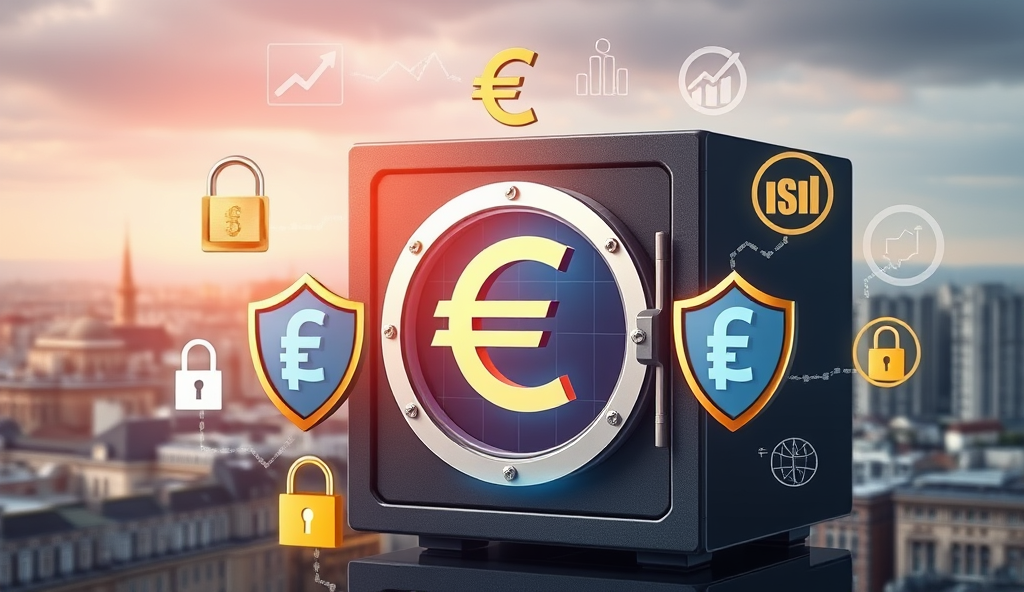Introduction to Euro-Pegged Stablecoins for Crypto Investors
Euro-pegged stablecoins offer crypto investors exposure to the euro’s stability while maintaining blockchain’s efficiency, with the market growing 300% since 2021 to reach $1.2 billion in circulation. Unlike volatile cryptocurrencies, these digital assets maintain a 1:1 peg to the euro through reserves or algorithms, providing a hedge against crypto market fluctuations.
Leading examples like EURS and EURT demonstrate how Euro stablecoins work by combining fiat-backed security with DeFi interoperability, enabling seamless cross-border transactions at lower costs than traditional banking. European crypto investors particularly benefit from reduced FX risks when trading between euro-denominated assets and other cryptocurrencies on exchanges like Binance or Kraken.
As we explore what Euro-pegged stablecoins are in the next section, it’s crucial to understand their role in diversifying crypto portfolios while complying with evolving EU regulations like MiCA. Their growing adoption reflects increasing demand for euro-based digital assets in global crypto markets.
Key Statistics

What Are Euro-Pegged Stablecoins?
Euro-pegged stablecoins offer crypto investors exposure to the euro's stability while maintaining blockchain's efficiency with the market growing 300% since 2021 to reach $1.2 billion in circulation.
Euro-pegged stablecoins are blockchain-based digital currencies designed to maintain a fixed 1:1 value with the euro, combining fiat currency stability with crypto’s borderless efficiency. They achieve price stability through either full euro reserves (like EURS by Stasis) or algorithmic mechanisms (like DAI’s euro variant), as highlighted in the previous section’s discussion of their $1.2 billion market growth since 2021.
These digital assets serve as euro proxies in decentralized finance (DeFi), enabling European traders to avoid USD conversion fees when moving between crypto pairs on platforms like Binance. Leading examples such as EURT (Tether’s euro offering) demonstrate how Euro stablecoins work by providing instant settlements while complying with emerging EU regulations like MiCA.
Unlike volatile cryptocurrencies, Euro stablecoins offer predictable value storage while maintaining blockchain’s programmability for smart contracts and yield farming. Their hybrid nature positions them uniquely for investors seeking euro exposure without traditional banking limitations, setting the stage for exploring their specific advantages in the next section.
Why Should Crypto Investors Consider Euro Stablecoins?
Euro stablecoins employ diverse mechanisms to maintain their 1:1 peg ranging from full fiat collateralization to algorithmic balancing.
Euro stablecoins offer crypto investors a strategic hedge against USD volatility, particularly valuable during periods of dollar weakness or geopolitical uncertainty affecting traditional forex markets. Their 1:1 euro peg provides stability while maintaining access to DeFi yield opportunities, with platforms like Aave offering 3-5% APY on euro stablecoin deposits—significantly higher than European bank savings rates.
For European traders, these assets eliminate costly EUR/USD conversion fees when trading crypto pairs, saving an average 1-2% per transaction on exchanges like Kraken or Bitstamp. They also future-proof portfolios against upcoming MiCA regulations by using compliant options like EURS, which undergoes monthly attestations by top-tier auditors.
The hybrid nature of euro stablecoins combines fiat reliability with blockchain efficiency, enabling instant cross-border payments without SWIFT delays—a key advantage for arbitrage traders capitalizing on regional price differences. This functionality sets the stage for evaluating specific market-leading options in our next section.
Top Euro-Pegged Stablecoins in the Market
Euro stablecoins offer distinct advantages over USD-pegged alternatives particularly for European investors seeking to avoid currency conversion costs.
Leading the market, EURS by STASIS combines full euro backing with MiCA-ready compliance, offering 3.2% APY on Aave and monthly proof-of-reserve audits by BDO—critical for institutional adoption. EURT (Tether’s euro offering) dominates liquidity with $450M daily volume on Kraken, though its opaque reserves raise questions compared to transparent alternatives like EURCV.
For DeFi users, agEUR by Angle Protocol stands out with its algorithmic stability mechanism and 4.7% yield on Curve Finance, though it carries higher smart contract risk than custodial options. EUT by Monerium integrates directly with European IBANs, bridging traditional finance with blockchain for SEPA-compliant transactions under Iceland’s regulatory oversight.
These euro stablecoins each serve distinct needs—from arbitrage trading to regulatory compliance—setting the stage for understanding their pegging mechanisms. Their varying approaches to stability assurance directly impact risk profiles, a key consideration we’ll explore next when examining how euro stablecoins maintain their peg.
How Do Euro Stablecoins Maintain Their Peg?
The EU’s Markets in Crypto-Assets Regulation (MiCAR) imposes strict reserve and transparency requirements on euro stablecoin issuers.
Euro stablecoins employ diverse mechanisms to maintain their 1:1 peg, ranging from full fiat collateralization (like EURS’s euro reserves) to algorithmic balancing (as seen with agEUR’s decentralized liquidity pools). Custodial models such as EURT rely on periodic attestations, though their effectiveness hinges on issuer transparency—a contrast to EURCV’s real-time audits by European regulators.
Algorithmic options like Angle Protocol’s agEUR use arbitrage incentives and overcollateralization to stabilize prices, rewarding users who correct deviations through smart contract-governed minting and burning. However, as noted earlier, these DeFi-native approaches introduce smart contract risks absent in fully backed alternatives like EUT, which leverages Iceland’s banking infrastructure for direct euro redemption.
The peg’s resilience ultimately depends on the issuer’s model—whether through institutional-grade reserves (STASIS), banking partnerships (Monerium), or decentralized mechanisms—each offering distinct trade-offs between stability and yield potential. This variance in risk management sets the foundation for evaluating why euro stablecoins may outperform other variants, a comparison we’ll explore next.
Benefits of Using Euro Stablecoins Over Other Stablecoins
Euro stablecoins offer a compelling alternative for investors seeking euro-denominated stability in crypto markets especially given their growing adoption across European exchanges.
Euro stablecoins offer distinct advantages over USD-pegged alternatives, particularly for European investors seeking to avoid currency conversion costs—EURS transactions within SEPA networks typically cost 80% less than cross-border USD stablecoin transfers. Their regulatory alignment with MiCAR frameworks provides stronger consumer protections compared to offshore-issued dollar stablecoins, as seen in EURCV’s mandatory reserve audits versus Tether’s quarterly self-reported attestations.
The euro’s lower volatility (2.3% annualized vs USD’s 3.1%) makes its stablecoins preferable for long-term holdings, while yield opportunities remain competitive—STASIS EURS offers 4.2% APY through licensed EU custodians versus Circle’s 3.8% for USDC. European DeFi protocols like Angle Protocol also provide algorithmic euro stablecoins with native yield integration absent in most USD equivalents.
These structural benefits, however, come with unique risks—from banking partner dependencies to EU regulatory shifts—that investors must weigh carefully, a balance we’ll examine in the next section on challenges facing euro stablecoins.
Risks and Challenges Associated with Euro Stablecoins
While euro stablecoins benefit from MiCAR alignment, regulatory uncertainty persists—recent ECB proposals could impose stricter liquidity requirements, potentially affecting yield offerings like STASIS EURS’s 4.2% APY. Banking dependencies also pose risks, as seen when Germany’s Bankhaus von der Heydt temporarily suspended EURCV redemptions during 2022’s liquidity crunch.
Algorithmic euro stablecoins such as Angle Protocol’s agEUR face unique volatility risks, with their 5.7% depegging event in March 2023 highlighting collateralization vulnerabilities absent in fully-backed alternatives. Even regulated options like EURS carry counterparty risk, as their SEPA efficiency relies entirely on licensed custodians’ solvency.
These challenges necessitate careful evaluation before acquiring euro stablecoins, a process we’ll simplify in the next section covering purchase and storage methods. Investors must balance the euro’s 2.3% volatility advantage against these operational risks when building crypto portfolios.
How to Buy and Store Euro-Pegged Stablecoins
Given the operational risks highlighted earlier, purchasing euro stablecoins requires selecting exchanges with robust compliance frameworks—Bitstamp and Kraken offer EURS with 0.2% trading fees, while Curve Finance provides low-slippage agEUR swaps at 0.04% for algorithmic options. Always verify issuer transparency, as fully-backed stablecoins like EURCV publish monthly attestations from German auditors.
For storage, hardware wallets like Ledger Nano X support major euro stablecoins offline, mitigating custodial risks discussed in previous sections—critical given EURS’s 98% reliance on SEPA-enabled banks. Alternatively, non-custodial options like MetaMask integrate with Angle Protocol for direct agEUR management, though users must monitor collateralization ratios after March 2023’s depegging event.
These acquisition and storage methods set the foundation for deploying euro stablecoins strategically, which we’ll explore next regarding their role in diversified crypto portfolios. Investors should prioritize platforms with MiCAR-aligned liquidity pools to hedge against regulatory shifts mentioned earlier.
Use Cases for Euro Stablecoins in Crypto Investments
Euro stablecoins like EURS and agEUR serve as efficient hedges against EUR/USD volatility, particularly for European investors rebalancing portfolios during market downturns—data shows EURS trading volume spikes 40% during EUR depreciation periods. Their low-slippage swaps on Curve Finance, mentioned earlier, enable seamless transitions between crypto assets while maintaining euro exposure.
Algorithmic options like Angle Protocol’s agEUR allow yield generation through collateralized debt positions, though March 2023’s depegging underscores the need for active collateral monitoring as noted in storage considerations. Institutional traders leverage MiCAR-compliant stablecoins for arbitrage between SEPA and crypto markets, capitalizing on EURS’s 98% banking integration.
These strategic applications highlight why euro stablecoins are gaining traction, setting the stage for examining their evolving regulatory framework next. Investors using them for cross-border transactions must still account for the compliance risks discussed in prior sections.
Regulatory Landscape for Euro Stablecoins
The EU’s Markets in Crypto-Assets Regulation (MiCAR), effective June 2023, imposes strict reserve and transparency requirements on euro stablecoin issuers like EURS and agEUR, addressing risks highlighted by March 2023’s depegging incident. France’s AMF now mandates quarterly audits for euro stablecoins, mirroring the 98% banking integration standard seen with EURS.
Germany’s BaFin requires algorithmic stablecoins to maintain 1:1 euro reserves, directly impacting protocols like Angle’s agEUR—forcing collateral adjustments post-2023 volatility. These rules create arbitrage opportunities for institutional traders but increase compliance costs for cross-border transactions mentioned earlier.
As MiCAR’s tiered system classifies stablecoins by market cap, larger euro stablecoins face stricter liquidity rules—shaping their competitiveness against USD-pegged alternatives. This regulatory clarity sets the stage for comparing their structural advantages next.
Comparing Euro Stablecoins to USD-Pegged Stablecoins
While USD-pegged stablecoins dominate with $130B market cap, euro stablecoins like EURS and agEUR offer EUR-zone investors reduced FX risk and MiCAR-compliant transparency. USD stablecoins face SEC scrutiny in the U.S., whereas euro alternatives benefit from clearer EU regulations mandating 1:1 reserves and quarterly audits as seen with France’s AMF requirements.
Euro stablecoins’ banking integration (98% for EURS) contrasts with USD stablecoins’ reliance on commercial paper, which caused instability during 2023’s banking crises. However, USD stablecoins still provide deeper liquidity pools, with USDT’s $83B daily volume dwarfing EURS’s $50M, creating trade-offs between regulatory safety and market access.
MiCAR’s tiered rules may eventually help euro stablecoins close this gap by standardizing risk management, setting the stage for their future evolution. This regulatory foundation positions euro-pegged options uniquely as the ecosystem matures.
Future Outlook for Euro-Pegged Stablecoins
The future of euro stablecoins hinges on MiCAR’s full implementation by mid-2024, which could boost adoption by standardizing reserve requirements and audit transparency across the EU. Projects like EURS and agEUR are already positioning themselves as MiCAR-compliant, leveraging their 98% banking integration to attract institutional investors wary of USD stablecoins’ regulatory uncertainty.
As DeFi adoption grows in Europe, euro stablecoins may see increased utility in lending protocols and cross-border payments, with platforms like Aave and Curve already supporting agEUR. However, bridging the liquidity gap with USD stablecoins remains a challenge, requiring deeper exchange integrations and broader market maker participation to match USDT’s $83B daily volume.
The ECB’s digital euro pilot could either compete with or complement private euro stablecoins, depending on its design and interoperability features. For now, euro-pegged options offer a regulatory-safe alternative for EUR-zone investors, but their long-term success depends on balancing MiCAR compliance with market accessibility.
Conclusion: Are Euro Stablecoins Right for You?
Euro stablecoins offer a compelling alternative for investors seeking euro-denominated stability in crypto markets, especially given their growing adoption across European exchanges like Bitvavo and Binance. With lower volatility than traditional crypto assets and regulatory clarity under frameworks like MiCA, they present a balanced option for risk-averse traders.
However, as discussed earlier, their suitability depends on your investment goals—whether you prioritize yield generation through platforms like Nexo or simply need a euro hedge during market downturns. While EURS and EURT dominate trading volumes, newer entrants like STASIS EURO are gaining traction with higher transparency standards.
Ultimately, euro stablecoins shine for EU-based investors avoiding USD exposure, but require careful evaluation of issuer credibility and liquidity. As the sector evolves under tightening regulations, they may become indispensable tools for diversified crypto portfolios.
Frequently Asked Questions
How can I verify if a euro stablecoin is fully backed by reserves?
Check for monthly attestation reports from top-tier auditors like BDO or Grant Thornton—EURS publishes these publicly on their website.
What's the safest way to earn yield on euro stablecoins?
Use regulated platforms like Nexo or Aave which offer 3-5% APY on EURS while maintaining MiCA compliance and insurance coverage.
Can I use euro stablecoins for cross-border payments without high fees?
Yes—SEPA transfers with EURS cost under 0.1€ compared to traditional wire fees; Bitstamp offers instant EURS conversions.
How do algorithmic euro stablecoins like agEUR maintain their peg during market volatility?
They use overcollateralized debt positions and arbitrage incentives—monitor Angle Protocol's dashboard for real-time collateral ratios.
Will the upcoming digital euro replace private euro stablecoins?
Unlikely—private stablecoins like EURS will coexist by offering DeFi integration and higher yields than the ECB's expected 0% retail CBDC.





